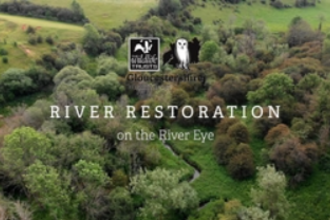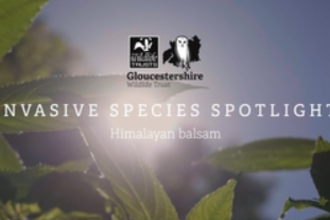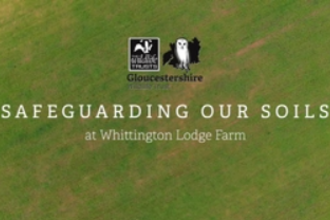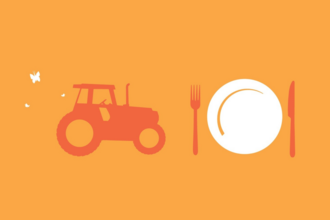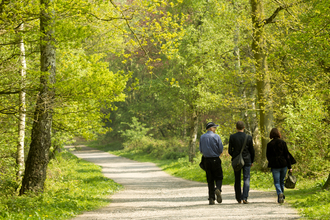
Climate change poster (c) Harrison Moore on Unsplash
Climate change in Gloucestershire
We are in the middle of a climate and nature emergency, and the two are inextricably linked. Climate change is driving nature’s decline, and the loss of wildlife and wild places leaves us ill-equipped to reduce carbon emissions and adapt to change. One cannot be solved without the other.
In 2022 you may have noticed leaves crunching underfoot in August. This was obviously far too early for autumn to have been kicking in, so what was going on?
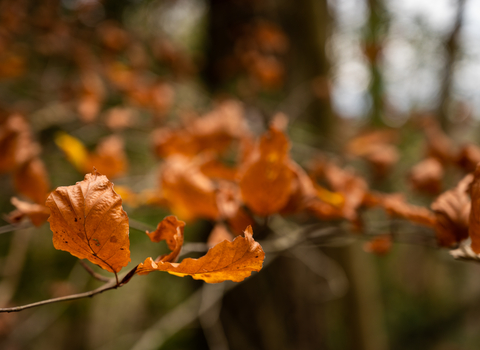
Frith Woods (c) Nathan Millar
False autumn
What we were seeing was the outcome of trees entering survival mode after the drought and recent heatwave. The days are still far too long for natural autumnal processes to kick in, but in an effort to survive the harsh weather they shed leaves and put out seeds as they became more stressed.
What will happen to the trees?
More established trees are mostly be able to cope with the harsh conditions, but those that are younger or in poor soils may not be able to cope.
What does a false autumn mean later on in the year?
A second spring may follow a period of heavy rain, with plants like ox-eye daisies being the first to pop up. Primroses may start to flower, trying to make the most out of the more hospitable weather. It's also likely that there wouldn't be as spectacular an autumnal scene as many of the trees would have already lost their leaves in the drought.
What are we doing to face the issues head on?
We know that climate change is ones of the biggest threats to wildlife, but there are two crucial things we’re doing moving forward.
Leaning into natural solutions
Natural solutions like wetland creation where we can hold back water and release it much slower. Wetlands help retain the water, and beavers can help to slow the flow to help with flooding, with carbon sequestration and water retention.
Connecting fragmented habitats
Wildlife needs to be able to move around to adapt to the changing climate, but what we have is a lot of habitats that are really fragmented so it’s very difficult for wildlife to move around, so we have something called the NRN which aims to link these places together across Gloucestershire. What wildlife likes is predictability, so an early autumn followed by a second spring is hard work for specialist species like farmland birds, so predictability is what we want but if that’s going to change then what we want is the ability to react to that.
That doesn’t just go for wildlife, but for humans as well. There’s something called survival ecology which talks about how we need to create places that can sustain the lives of the future, to enable wildlife to exist but also to enable the things that we need from the wild.
There’s an assumption that we’re going to be able to solve all the problems with technology, but we can’t, nature is so complex that can’t hope to replicate it, so we need to help build its resilience.
From the Cotswold Rivers Living Landscape Programme aiming to reconnect and restore healthy river habitats, to working with farmers to explore the positive impacts of regenerative farming, discover more with the short films below.
Changes that could be seen here in Gloucestershire
While we are aware of the global impact of climate change and global warming, what are the effects that we could see if real and meaningful change is not carried out?
Loss of water vole habitat in the Severn Vale
One of our beloved mammals, the water voles, would find it more difficult to live in this county. Increasingly unpredictable severe flooding events may mean that water vole habitats in the Severn Vale will become unviable.
This would be catastrophic for these charming creatures, as evidence has shown that they've undergone long term declines across the UK, with some studies indicating they've disappeared from 94% of their former sites.
Water voles dig extensive and complex burrow systems into the banks of waterways, consisting of sleeping chambers at various levels and underwater entrances to give them safe routes for escape.

Water vole © Terry Whittaker/2020VISION
Loss of saltmarsh habitats due to rising sea levels
One of the seemingly contradictory changes we’ll see is that saltmarsh habitats along the Severn will be lost to rising sea-level rises while droughts become more common. At a whopping 220 miles long, the River Severn is the longest river in Great Britain, with the Severn estuary making up 40 miles of its length. An impressive bore (a mini tidal wave) pushes its way up the river at various times throughout the year.
The Severn estuary represents about 4% of the total area of saltmarsh in the UK and supports internationally important numbers of aquatic invertebrates and waterfowl. Plants here are called halophytes and have adapted to thrive in the salty intertidal environment found here, but if sea levels rise then these areas will be submerged all the time and lost completely.
Curlew, shelducks, redshank, and other bird species that call this niche habitat home would no longer be able to find the food they’re looking for and the shelter for their young.
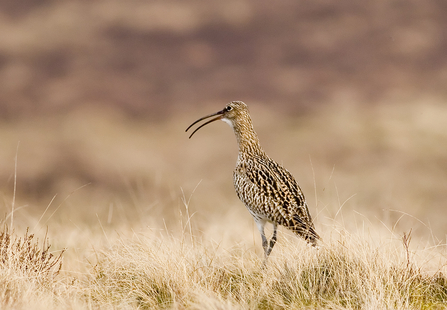
Curlew (c) Damian Waters
Considerable loss of beech trees by 2050
While overall beech trees are likely to expand their range in the UK, across the south and in Gloucestershire, conditions are likely to become unsuitable due to temperature rises and the soil type found here.
Beech trees are sensitive to both extremes of wet and dry conditions, while are likely to become more severe and unpredictable. The lowland areas with free-draining soils, like those found in the Cotswolds, make beeches particularly sensitive to the prolonged summer droughts which will become more commonplace. Droughts put the trees under stress, reducing their growth which is turn reduces leaf cover, leaving them less able to fight infections and reduces seed production. This will result in a downward spiral for the current beech populations.
Beech trees also have shallow root systems, so droughts followed by wet conditions could lead them to fall.
We have a number of veteran beech trees at Crickley Hill that would be at risk. Veteran beeches range from 125 to over 200 years of age, and while veteran trees aren’t as old or complex as ancient trees, they still provide holes, cavities and crevices which are especially important for wildlife.
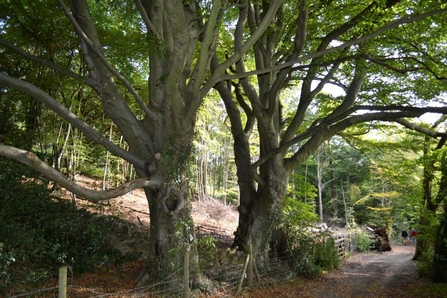
Beech Woodland
Brown trout under threat
Water temperature is one of the most important factors that impact fish populations, especially cold-water species like brown trout. Both their body temperature and their metabolism are regulated by their environment, the water.
Changes in temperature will also impact breeding. Female trout (called hens) start building their nests, known as redds, in the gravelly riverbed from November to January when the water is cold and carrying lots of oxygen as that’s what the eggs need to hatch.
Predicted changes in rain patterns and more frequent flash flooding will also negatively influence breeding occurrence, success, and can lead to less stable spawning grounds.
As well as directly putting their bodies under pressure and impacting breeding, higher water temperatures can increase the emergence of diseases like proliferative kidney disease (PKD), depleting the already stressed populations.
While genetic variance could partially compensate for the effects of changes temperatures, the rapid changes predicted will leave the fish with no time to adapt.
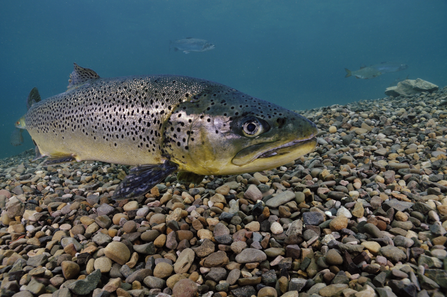
Brown trout (c) Linda Pitkin/2020VISION
A devastating impact on insect populations
A changing climate alters the timing of the seasons and can have huge impacts on the growth of plants. While this can be devastating for the plants themselves, it will have knock-on effects on a plethora of other species.
Insects’ life cycles are synchronised with the plants their larvae rely on to survive, called larval foodplants. If seasons arrive later or earlier, this can in turn have negative impacts on birds, which rely on a supply of caterpillars not only to survive themselves but to feed their young.
Increased periods of drought will also mean that will be fewer foodplants for rare limestone grassland butterflies.
Lots of species may start migrating northwards to cope with rising temperatures, so we could see a loss of lots of insect species while others from further south move in to take advantage of the new territories.
While some places may become hot and dry, other places can become cooler or wetter. Some species, like the garden tiger moth, have adapted to survive long frosty winters don’t do as well with the milder wetter winters, and indeed has declined massively since the 70s and continues to do so.
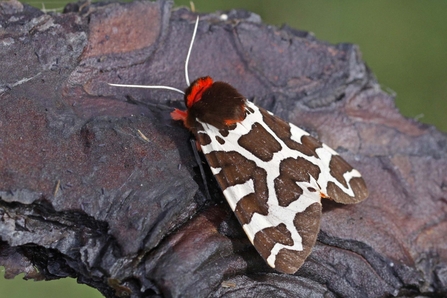
Garden tiger moth ©Margaret Holland

